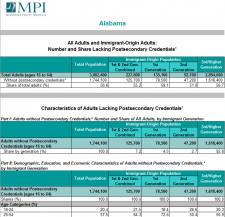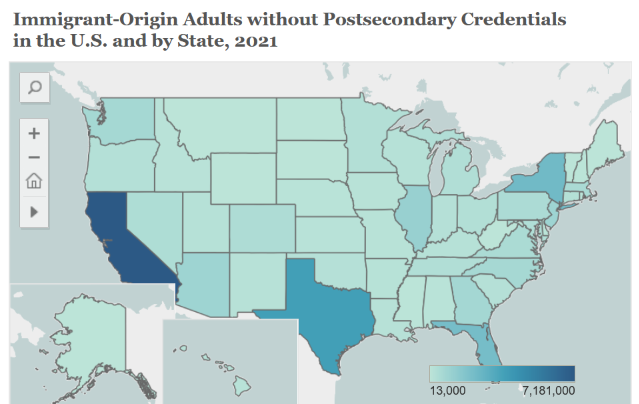Immigrant-Origin Adults without Postsecondary Credentials: A 50-State Profile
Immigrants and their U.S.-born children, who together comprise the immigrant-origin population, are an important if sometimes under-recognized source of talent for U.S. and state economies. With the country facing both an aging population and declining birth rate, immigrant-origin adults are expected to provide nearly all labor-force growth in the next two decades.
Many first- and second-generation adults already have postsecondary credentials (i.e., academic degrees or professional certifications and licenses), but approximately 30 million do not. These adults are an important target for efforts to build up the skills of the workforce as the U.S. economy becomes ever more knowledge based.
This fact sheet provides a profile of immigrant-origin adults without postsecondary credentials nationwide and for 50 states and the District of Columbia. It explores key state-level and regional trends behind the nationwide findings described in the MPI report it accompanies: Credentials for the Future: Mapping the Potential for Immigrant-Origin Adults in the United States.
Among the key takeaways from this state-level analysis:
- Immigrant-origin adults made up 30 percent of all adults without postsecondary credentials nationwide in 2017, but considerably higher shares in states such as California, New York, Nevada, and Massachusetts.
- First-generation immigrant adults are less likely to hold postsecondary credentials than their U.S.-born counterparts in most but not all states; in several Rust Belt states, including Michigan and Ohio, they are more likely to hold such credentials.
- In most states, the second generation outperforms the first, attaining postsecondary credentials at rates that are similar to those of U.S.-born adults from nonimmigrant families.
I. Introduction
II. Why Focus on Immigrant-Origin Adults?
III. Postsecondary Credential Attainment and Gaps across States
A. Immigrant Generation
B. Place of Residence
C. Race and Ethnicity
D. Legal Status
E. Educational Attainment
F. English Proficiency of All U.S. Adults without Postsecondary Education
IV. Conclusions





